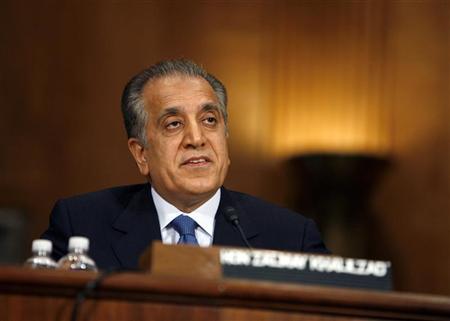
The shuttle diplomacy being carried out by Zalmay Khalilzad over the 17-year-old conflict in Afghanistan has rekindled a new spirit of optimism. The move has signaled an upturn for peace in the region. This, to a varying degree, resembles the deliberations amidst Cuban Missiles Crisis that brought John F Kennedy, Pope John and Khrushchev to the negotiating table. In that case, the realisation of the vulnerability of the human civilisation to the destructive power of the advanced technology got them together and consequently the possibility of the missile crisis leading to a World War-III was averted with a remarkable display of diplomacy. Some other good examples of defusing of volatile situation were the cessation of hostilities following the Yom Kippur War, the Sinai Interim Agreement (1975) and arrangements between Israel and Syria on the Golan Heights (1974) and the Camp David Accord between Israel and Egypt.
“Politics is the art of the possible” and “there are no permanent friends or permanent enemies, only permanent interests”. In the wake of new developments in the region and given the geopolitical and socio-economic conditions — particularly the geographical position of Afghanistan at the junction of several nuclear powers aspiring to be regional leaders — peace is essential. Peace has, however, been marred due to ever-increasing threats of insurgencies and acts of terrorism in South Asia. With the escalation of terrorist activities since 1983-84, terrorism has become the major policy concern and a key determinant of relations with other countries. History is also replete with examples where terrorist acts generated big wars. For instance, the assassination of Archduke Ferdinand of Austria ignited the World War-I. Acts of terror have brought India and Pakistan, the two nuclear powers to the brink of war several times in the recent past which was then averted with the intervention of superpowers.
Afghanistan’s conundrum is also a result of the transnational terrorism culminating into 9/11. With the shattering of the capacity of al Qaeda, emergence of the IS notwithstanding, the US wants to walk out while economic interests drive the other major players in the region such as China, Russia, Central Asian states, Pakistan, Iran and India towards peace. All these players are not only parties to the parleys but also pose to be guarantors. At the same time today, Afghanistan is fractious politically. The Taliban appear to be a homogenous group while other segments are divided into different groups. The divergent opinion over the future setup and the acceptance of the legitimacy of the present regime by the Taliban is the major bottleneck. Despite all stumbling blocks, peace is imperative for all players in the region.
Afghanistan and Central Asia have active engagements on several fronts. This will most immediately offer Afghanistan a northern route to Central Asia, across the Caspian Sea to Azerbaijan, and on to Europe.
The option of northern engagement is a motivating factor for Pakistan and Iran to upgrade their infrastructure and secure their territory, with an opportunity to take part in the export of Afghanistan’s abundant minerals, estimated to be worth more than three trillion dollars.
Each Central Asian state is multiethnic, with Afghanistan having similarity as it inhabits Uzbeks, Tajiks, Turkmen, and Kyrgyz, and Uzbek is an officially-recognised language under the Afghan constitution. Observing successful role models like Kazakhstan and Uzbekistan can be a learning experience for the people of Afghanistan. The links of language and culture can cement ties between Afghanistan and Central Asia, as the people on both sides of the Amu Darya see it as not a barrier, but a pathway.
From the perspective of China, peace in Afghanistan is imperative to make the One Belt One Road initiative a success. The scheme has been perceived keeping Central Asia, Russia and Europe in mind. Such a venture will connect China with Europe. China has huge investments in oil and gas resources in Kyrgyzstan, Kazakhstan, Tajikistan, Turkmenistan, and Uzbekistan. China is eager to take advantage of the current international climate — that features evolving international alliances — giving China the opportunity to exploit a new resource market. This will have a direct positive impact creating conducive atmosphere for the Chinese and others to invest in transport infrastructure going through Central Asia. Involvement in minerals, copper, iron, gas and petroleum (Aynak Copper mine and Hajigak Iron ore deposit) are the prime interests.
Russia’s overarching security interests, mainly transnational terrorism and drug trafficking, align with Afghan and American objectives. Moscow’s efforts can be useful when they are well defined and are held in unison with efforts by Afghanistan and the US, as two major parties to the conflict. Russia is trying to meet Afghanistan’s needs, with a commitment to sustain security ties and strengthen Tajikistan’s border security per arms agreements. Russia’s growing economic ventures with Central Asia, China and Iran pave the way for peace. With the opening up of these corridors of trade, Pakistan also has the great opportunity to flourish its trade for formation of capital and further investment.
In view of the aforementioned factors, it can be argued that conditions are ripe for a peaceful Afghanistan. Peace has a great chance if all the stakeholders within the region and inside Afghanistan adopt a win-win situation for all. However, it merits a mention that the Taliban’s religio-political motive of an Islamic state may be a stumbling block. Global fraternity has to ensure that the Taliban and the rest of the parties in Afghanistan respect human rights, remain gender-sensitive, ensure basic human rights and provide equal opportunities to all Afghan citizens. This seems a formidable challenge but for long-lasting and sustainable peace in Afghanistan, these are the basic prerequisites.
Published in The Express Tribune, June 12th, 2019.
Like Opinion & Editorial on Facebook, follow @ETOpEd on Twitter to receive all updates on all our daily pieces.






























































COMMENTS
Comments are moderated and generally will be posted if they are on-topic and not abusive.
For more information, please see our Comments FAQ